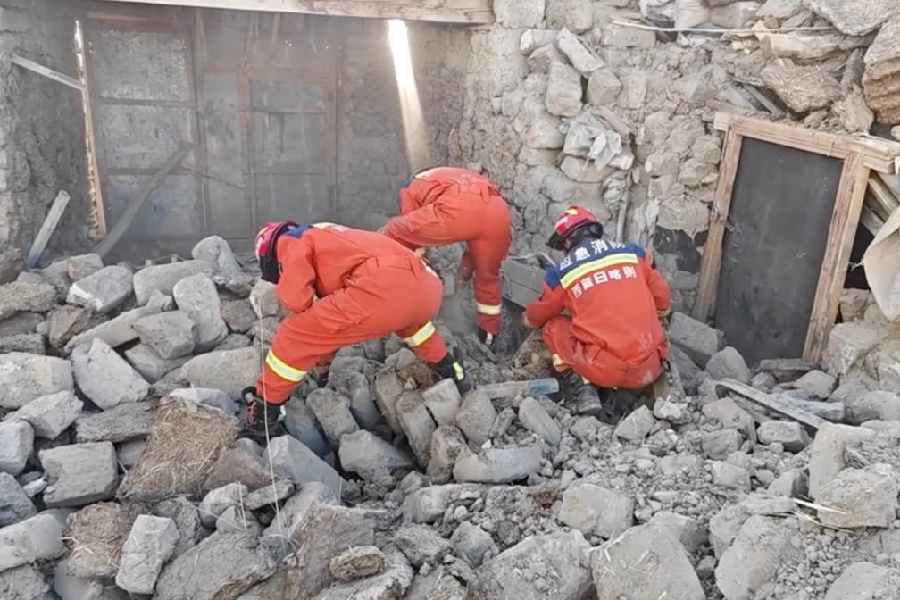Dozens of people were killed and hundreds of buildings crumbled as a 7.1-magnitude earthquake struck a region near one of Tibet’s holiest cities, close to the Himalayan border with Nepal, on Tuesday. Tremors were felt in Nepal.
The quake struck shortly after 9am at a depth of 10km in Tingri County in Tibet, Chinese state media reported. They said at least 126 people had died and 188 were injured. Xinhua, the official news agency, published videos of police removing rubble and lifting debris.
Tingri, the epicentre, is a seismically active area where the India and Eurasia plates clash and can cause earthquakes strong enough to change the heights of some of the world’s tallest peaks in the Himalayan mountains.
China’s state broadcaster reported that more than 1,000 houses had collapsed in Tingri County, which sits on the northern foothills of Mount Everest.
Several aftershocks were felt in the area, including in Nepal. The quake had a magnitude of 7.1, according to the US Geological Survey, though it was measured as 6.8 by the China Earthquake Networks Centre.
The nearest city to the earthquake’s epicentre was Shigatse, the second-largest city in Tibet that is close to the border with India and has a population of 640,000. Shigatse is regarded as a holy site because it is the seat of the Panchen Lama, one of the most senior figures in Tibetan Buddhism.
A tourist not far from Shigatse who spoke to The New York Times said she was in her hotel room when the building started shaking. She said the electricity went out and that she and a friend squatted between the beds. When the shaking stopped, they ran out of the building.
The tourist, who only gave her surname, Xu, shared a video showing several single-storey brick buildings with collapsed walls. Video posted on Chinese social media showed streets strewed with rubble, cars crushed by fallen bricks and roads split open by the shifted ground. Xu said she grabbed her down jacket before she ran out.
China’s top leader, Xi Jinping, ordered officials to minimise casualties and resettle survivors. The Chinese authorities deployed 1,500 rescuers and more than 250 vehicles for the search effort, which was taking place in frigid conditions, with temperatures dipping as low as minus 15° Celsius.
In photos published by state media, rescuers appeared to be digging through piles of rubble from toppled houses using ropes and shovels and working by hand.
Rescue workers climbed mounds of broken bricks, some using ladders in heavily damaged villages, as they searched for survivors.
Videos posted by China’s ministry of emergency management showed two people being carried out on stretchers by workers treading over the uneven debris from collapsed homes.
The area that Tuesday’s quake hit had over the past century witnessed 10 earthquakes of at least magnitude 6, the US Geological Survey said.
About 50 aftershocks were recorded in the three hours after the earthquake, and the Mount Everest scenic area on the Chinese side was closed.
Chinese Vice-Premier Zhang Guoqing was dispatched to the area to guide the work, and the government announced the allocation of 100 million yuan ($13.6 million) for disaster relief.
Some 22,000 disaster relief items, including cotton tents, cotton coats, quilts and folding beds, together with special relief materials for high-altitude and frigid areas, have beendispatched to the quake-hit area.
About 6,900 people live in three townships and 27 villages within 20km of the epicentre on the Chinese side, state media said. The average altitude in the area is about 13,800 feet, the Chinese earthquake centre said in a social media post.
On the southwest edge of Kathmandu, a video showed water spilling out into the street from a pond in a courtyard with a small temple.
“It is a big earthquake,” a woman can be heard saying. “People are all shaking.”
The Himalayan region is prone to powerful earthquakes. In 2015, a quake in Nepal with a magnitude of 7.8 killed nearly 9,000 people.
In Kathmandu, residents streamed out of their homes on Tuesday morning as the earthquake rattled buildings.
At least two people, onein Kathmandu and another in Sindhupalchowk, a district north of Kathmandu, suffered minor injuries from thequake, according to Nepalese police.
Nepal sent more than 2,500 police officers to assess the damage and look for victims.
“Based on the magnitude of the earthquake, there could be some damage in the mountains of eastern Nepal,” said Lok Bijaya Adhikari, a senior seismologist at Nepal’s National Earthquake Monitoring and Research Centre.
Most residents from Nepal’s high mountain regions such as Everest, Makalu, Rolwaling and Kanchenjunga have migrated to lowland areas to avoid the extreme cold of winter.
“Although most people migrate to lower land during winter, some are still there,” said Ang Tshering Sherpa, former chief of the Nepal Mountaineering Association.
“There’s always the risk of avalanches and glacial lake outburst floods after earthquakes.”
New York Times News Service and Agencies











